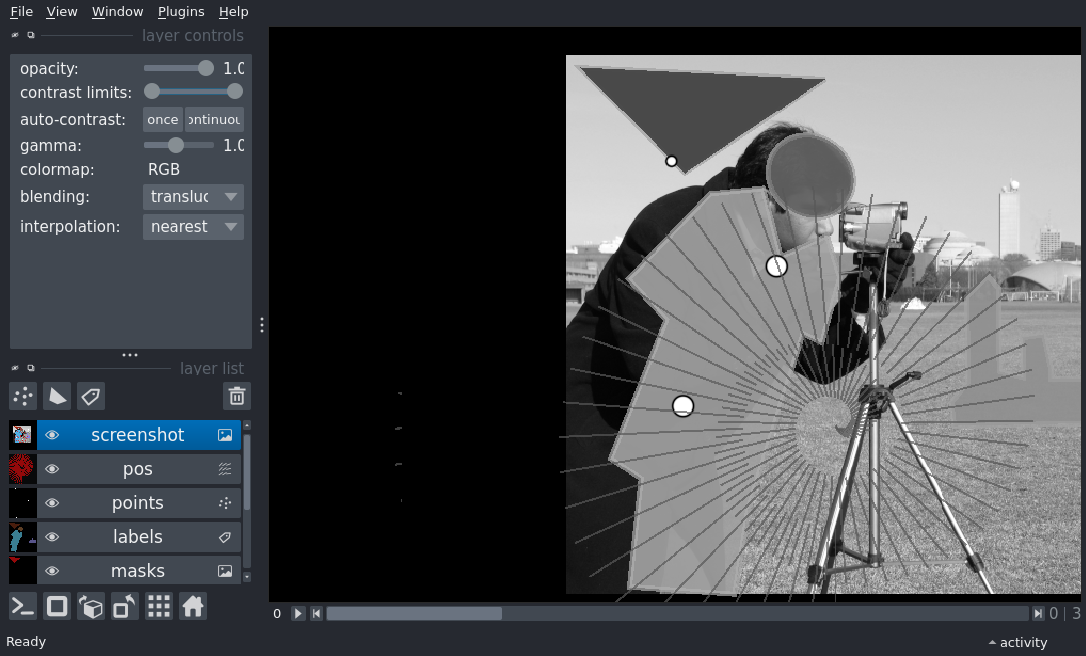Note
Click here to download the full example code
To screenshot¶
Display one shapes layer ontop of one image layer using the add_shapes and
add_image APIs. When the window is closed it will print the coordinates of
your shapes.

import numpy as np
from skimage import data
import napari
from vispy.color import Colormap
# create the viewer and window
viewer = napari.Viewer()
# add the image
img_layer = viewer.add_image(data.camera(), name='photographer')
img_layer.colormap = 'gray'
# create a list of polygons
polygons = [
np.array([[11, 13], [111, 113], [22, 246]]),
np.array(
[
[505, 60],
[402, 71],
[383, 42],
[251, 95],
[212, 59],
[131, 137],
[126, 187],
[191, 204],
[171, 248],
[211, 260],
[273, 243],
[264, 225],
[430, 173],
[512, 160],
]
),
np.array(
[
[310, 382],
[229, 381],
[209, 401],
[221, 411],
[258, 411],
[300, 412],
[306, 435],
[268, 434],
[265, 454],
[298, 461],
[307, 461],
[307, 507],
[349, 510],
[352, 369],
[330, 366],
[330, 366],
]
),
]
# add polygons
layer = viewer.add_shapes(
polygons,
shape_type='polygon',
edge_width=1,
edge_color='coral',
face_color='royalblue',
name='shapes',
)
# change some attributes of the layer
layer.selected_data = set(range(layer.nshapes))
layer.current_edge_width = 5
layer.current_opacity = 0.75
layer.selected_data = set()
# add an ellipse to the layer
ellipse = np.array([[59, 222], [110, 289], [170, 243], [119, 176]])
layer.add(
ellipse,
shape_type='ellipse',
edge_width=5,
edge_color='coral',
face_color='purple',
)
masks = layer.to_masks([512, 512])
masks_layer = viewer.add_image(masks.astype(float), name='masks')
masks_layer.opacity = 0.7
masks_layer.colormap = Colormap([[0.0, 0.0, 0.0, 0.0], [1.0, 0.0, 0.0, 1.0]])
labels = layer.to_labels([512, 512])
labels_layer = viewer.add_labels(labels, name='labels')
points = np.array([[100, 100], [200, 200], [333, 111]])
size = np.array([10, 20, 20])
viewer.add_points(points, size=size)
# sample vector coord-like data
n = 100
pos = np.zeros((n, 2, 2), dtype=np.float32)
phi_space = np.linspace(0, 4 * np.pi, n)
radius_space = np.linspace(0, 100, n)
# assign x-y position
pos[:, 0, 0] = radius_space * np.cos(phi_space) + 350
pos[:, 0, 1] = radius_space * np.sin(phi_space) + 256
# assign x-y projection
pos[:, 1, 0] = 2 * radius_space * np.cos(phi_space)
pos[:, 1, 1] = 2 * radius_space * np.sin(phi_space)
# add the vectors
layer = viewer.add_vectors(pos, edge_width=2)
# take screenshot
screenshot = viewer.screenshot()
viewer.add_image(screenshot, rgb=True, name='screenshot')
# from skimage.io import imsave
# imsave('screenshot.png', screenshot)
if __name__ == '__main__':
napari.run()